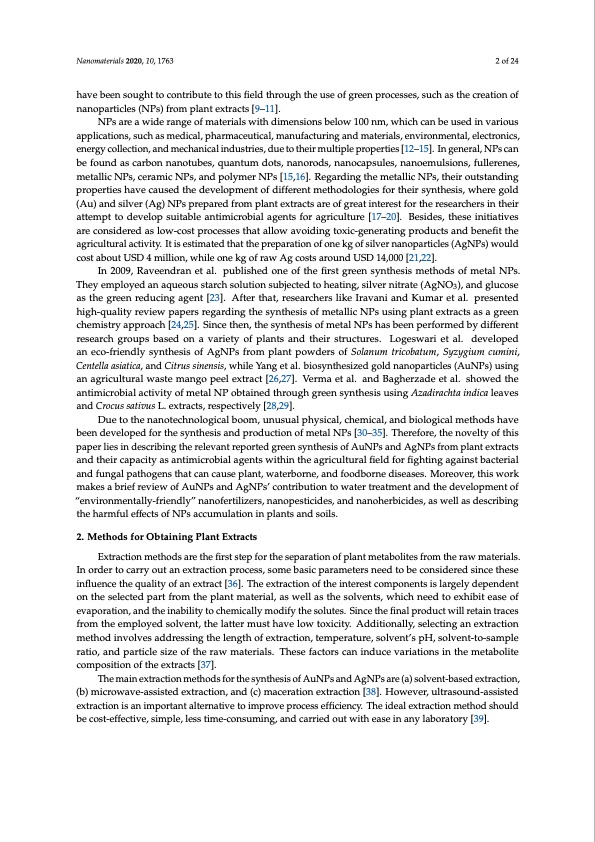
PDF Publication Title:
Text from PDF Page: 002
Nanomaterials 2020, 10, 1763 2 of 24 have been sought to contribute to this field through the use of green processes, such as the creation of nanoparticles (NPs) from plant extracts [9–11]. NPs are a wide range of materials with dimensions below 100 nm, which can be used in various applications, such as medical, pharmaceutical, manufacturing and materials, environmental, electronics, energy collection, and mechanical industries, due to their multiple properties [12–15]. In general, NPs can be found as carbon nanotubes, quantum dots, nanorods, nanocapsules, nanoemulsions, fullerenes, metallic NPs, ceramic NPs, and polymer NPs [15,16]. Regarding the metallic NPs, their outstanding properties have caused the development of different methodologies for their synthesis, where gold (Au) and silver (Ag) NPs prepared from plant extracts are of great interest for the researchers in their attempt to develop suitable antimicrobial agents for agriculture [17–20]. Besides, these initiatives are considered as low-cost processes that allow avoiding toxic-generating products and benefit the agricultural activity. It is estimated that the preparation of one kg of silver nanoparticles (AgNPs) would cost about USD 4 million, while one kg of raw Ag costs around USD 14,000 [21,22]. In 2009, Raveendran et al. published one of the first green synthesis methods of metal NPs. They employed an aqueous starch solution subjected to heating, silver nitrate (AgNO3), and glucose as the green reducing agent [23]. After that, researchers like Iravani and Kumar et al. presented high-quality review papers regarding the synthesis of metallic NPs using plant extracts as a green chemistry approach [24,25]. Since then, the synthesis of metal NPs has been performed by different research groups based on a variety of plants and their structures. Logeswari et al. developed an eco-friendly synthesis of AgNPs from plant powders of Solanum tricobatum, Syzygium cumini, Centella asiatica, and Citrus sinensis, while Yang et al. biosynthesized gold nanoparticles (AuNPs) using an agricultural waste mango peel extract [26,27]. Verma et al. and Bagherzade et al. showed the antimicrobial activity of metal NP obtained through green synthesis using Azadirachta indica leaves and Crocus sativus L. extracts, respectively [28,29]. Due to the nanotechnological boom, unusual physical, chemical, and biological methods have been developed for the synthesis and production of metal NPs [30–35]. Therefore, the novelty of this paper lies in describing the relevant reported green synthesis of AuNPs and AgNPs from plant extracts and their capacity as antimicrobial agents within the agricultural field for fighting against bacterial and fungal pathogens that can cause plant, waterborne, and foodborne diseases. Moreover, this work makes a brief review of AuNPs and AgNPs’ contribution to water treatment and the development of “environmentally-friendly” nanofertilizers, nanopesticides, and nanoherbicides, as well as describing the harmful effects of NPs accumulation in plants and soils. 2. Methods for Obtaining Plant Extracts Extraction methods are the first step for the separation of plant metabolites from the raw materials. In order to carry out an extraction process, some basic parameters need to be considered since these influence the quality of an extract [36]. The extraction of the interest components is largely dependent on the selected part from the plant material, as well as the solvents, which need to exhibit ease of evaporation, and the inability to chemically modify the solutes. Since the final product will retain traces from the employed solvent, the latter must have low toxicity. Additionally, selecting an extraction method involves addressing the length of extraction, temperature, solvent’s pH, solvent-to-sample ratio, and particle size of the raw materials. These factors can induce variations in the metabolite composition of the extracts [37]. The main extraction methods for the synthesis of AuNPs and AgNPs are (a) solvent-based extraction, (b) microwave-assisted extraction, and (c) maceration extraction [38]. However, ultrasound-assisted extraction is an important alternative to improve process efficiency. The ideal extraction method should be cost-effective, simple, less time-consuming, and carried out with ease in any laboratory [39].PDF Image | Green Synthesis of Gold and Silver Nanoparticles from Plant Extracts

PDF Search Title:
Green Synthesis of Gold and Silver Nanoparticles from Plant ExtractsOriginal File Name Searched:
nanomaterials-10-01763.pdfDIY PDF Search: Google It | Yahoo | Bing
Turbine and System Plans CAD CAM: Special for this month, any plans are $10,000 for complete Cad/Cam blueprints. License is for one build. Try before you buy a production license. More Info
Waste Heat Power Technology: Organic Rankine Cycle uses waste heat to make electricity, shaft horsepower and cooling. More Info
All Turbine and System Products: Infinity Turbine ORD systems, turbine generator sets, build plans and more to use your waste heat from 30C to 100C. More Info
CO2 Phase Change Demonstrator: CO2 goes supercritical at 30 C. This is a experimental platform which you can use to demonstrate phase change with low heat. Includes integration area for small CO2 turbine, static generator, and more. This can also be used for a GTL Gas to Liquids experimental platform. More Info
Introducing the Infinity Turbine Products Infinity Turbine develops and builds systems for making power from waste heat. It also is working on innovative strategies for storing, making, and deploying energy. More Info
Need Strategy? Use our Consulting and analyst services Infinity Turbine LLC is pleased to announce its consulting and analyst services. We have worked in the renewable energy industry as a researcher, developing sales and markets, along with may inventions and innovations. More Info
Made in USA with Global Energy Millennial Web Engine These pages were made with the Global Energy Web PDF Engine using Filemaker (Claris) software.
Infinity Turbine Developing Spinning Disc Reactor SDR or Spinning Disc Reactors reduce processing time for liquid production of Silver Nanoparticles.
| CONTACT TEL: 608-238-6001 Email: greg@infinityturbine.com | RSS | AMP |